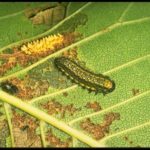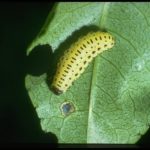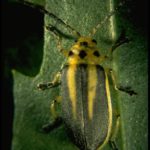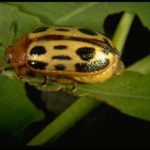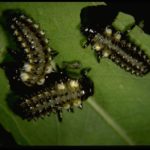Common Name: Leaf beetle
Scientific Name: Varies
Order: Coleoptera
Description: Adult beetles are about 1/4 inch long, overall yellow to brownish-green in body color, and marked with black spots on the head and thorax, and broad black stripes following the outer wing cover (elytra) margins. Larvae grow to about ½ inch and are yellowish with black spots and broad stripes along the sides. Pupae are 1/4 inch long and are bright orange-yellow with scattered black bristles.
There are many other leaf feeding (chrysomelid) beetles. The larger elm leaf beetle, Monocesta coryli (Say) is less common and feed on elm and some other trees. Larvae are larger (13 mm) metallic red brown, and adults are dull yellowish brown with a dull green band at the end of the wing covers. The cottonwood leaf beetle, Chrysomela scripta Fabricius, feed on cottonwood leaves.
- Elm leaf beetle, Pyrrhalta luteola (Müller) (Coleoptera: Chrysomelidae), larvae and eggs. Photo by M. E. Merchant.
- Flea beetle, (Coleoptera: Chrysomelidae), larva on prickly ash and Hercules club. Photo by Drees.
- Leaf beetle, Trirhabda bacharidis (Weber) (Coleoptera: Chrysomelidae), common on bacharus. Photo by Drees.
- Cottonwood leaf beetle, Chrysomela scripta Fabricius (Coleoptera: Chrysomelidae). Adult on willow. Photo by Drees.
- Cottonwood leaf beetle, Chrysomela scripta Fabricius (Coleoptera: Chrysomelidae). Larvae on willow. Photo by Drees.
Life Cycle: Adult beetles spend the winter in protected sites, occasionally in homes. Beetles fly to elm trees in the spring, feed on newly-emerged foliage and deposit clusters of 5 to 25 lemon-shaped yellow eggs in two or three rows on the underside of leaves. In about 7 days, small black larvae hatch and feed on the underside of leaves. Larvae develop through several stages (instars) for about 21 days. Mature larvae crawl down the tree trunk and pupate in the soil at the base of the tree. Adult beetles emerge from pupae in about 14 days. Three or more generations can occur per year.
Habitat and Food Source(s): Mouthparts are for chewing. This is an introduced species that feeds on elm tree varieties, especially the Siberian and European elms. Cedar elm, American elm and winged elm are less susceptible when other hosts are available.
Pest Status: Larvae and adult stages are harmless to man and animals, but feed on leaves of elm trees causing unsightly damage and premature defoliation; medically harmless.
Damage: Larvae skeletonize foliage by removing the parts of the leaves between the leaf veins, leaving the upper leaf surface intact. Injured portions of leaves soon turn rusty, reddish-brown, and dry skeletonized leaves fall to the ground. Adults eat roughly circular holes in leaves.
For additional information, contact your local Texas A&M AgriLife Extension Service agent or search for other state Extension offices.
Literature: Johnson & Lyon 1989; Turney & Crocker 1980.
